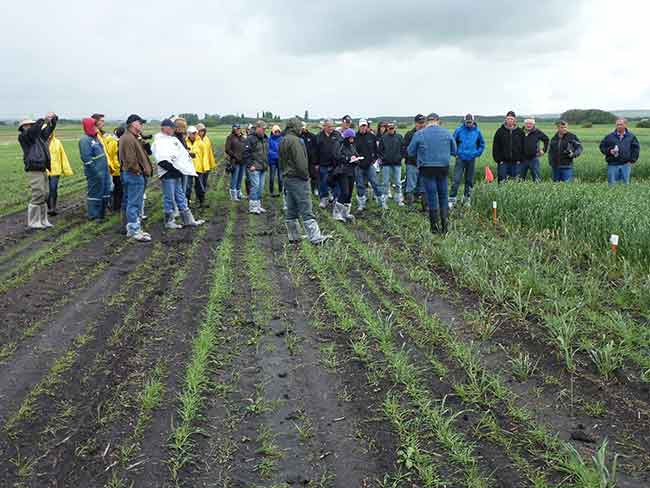
Features
Business & Policy
Business Management
Improving winter wheat
Winter wheat is an important crop in many cropping systems, however poor stand establishment and winter survival continue to be challenges to crop expansion in Western Canada. Seed treatments and fall foliar fungicide applications in other growing areas show benefits of improved crop competitiveness and yield, however little research has been done in Western Canada.
Researchers from Agriculture and Agri-Food Canada (AAFC) conducted a three-year study across Western Canada from 2011 to 2013 to determine if seed treatments could improve crop competitiveness of winter wheat and whether or not there were differences in responses between active ingredients, which target a different spectrum of the pathogen/insect complex in the soil. They also wanted to assess if fall application of foliar fungicide improved crop health, vigour, and competitiveness, and yield alone or in combination with particular seed treatments.
“We set out to identify alternative strategies that would help ensure good stand establishment and overwintering success of winter wheat crops across the Prairies,” explains Kelly Turkington, research scientist with AAFC at Lacombe, Alta. “We also wanted to look at options that would help manage disease development the following spring, such as stripe rust and leaf spot diseases like tan spot or septoria. Research from other areas, like Australia, shows that seed treatments with the right active ingredients can help slow down early rust development. We compared different seed treatments with different actives as a way to assess which factors were the most important. We also wanted to determine if a fall application of fungicide would provide any benefits for crop survival from one growing season to the next.”
This direct-seeded study was conducted at nine sites across Western Canada over three growing seasons. The trials assessed the response of the winter wheat cultivar CDC Buteo to seed treatments and fall-applied fungicides. Five levels of seed treatment were compared: check–no seed treatment, tebuconazole, metalaxyl, imidacloprid and a dual fungicide/insecticidal seed treatment of tebuconazole + metalaxyl + imidacloprid. Two levels of fall-applied fungicide were compared, a check–no application or a foliar-applied prothioconazole performed in mid-October.
Overall, the results showed a yield benefit by using seed treatments, with the dual fungicide/insecticide seed treatment providing the highest yield and net returns. The neonicotinoid seed treatment, imidicloprid, and the fungicide seed treatment, tebuconazole, generally provided intermediate grain yields and net returns, while the check and the fungicide seed treatment, metalaxyl, produced similar low grain yields and returns. Fungicide seed treatments have been effective in improving winter wheat stand establishment and yield when seed infection with Fusarium graminearum is a concern.
“The study showed some benefit from the fall foliar fungicide treatment, however the increase was small and resulted in decreased net returns,” says Turkington. “In areas with confirmed stripe rust in the fall, the yields gains were a bit better, however the cost of application is prohibitive at this point compared to no application. For now, a timely spring foliar fungicide application focusing at either the flag leaf emergence stage for leaf spot management or a bit later at anthesis timing for managing Fusarium head blight and leaf spot disease is still recommended when there is a risk of disease. We need to do more research on fall foliar fungicide application alone or in combination with a spring application to see if there are economical benefits. We also need to do additional work on seed treatments to determine if early season leaf disease management can be improved in both winter and spring cereals.”
{gallery}19554{/gallery}
Another four-year study is underway in Western Canada comparing four winter wheat varieties of various levels of resistance with the timing of four different foliar fungicide treatments: check–no application, fall application only, spring application at flag leaf, and a dual fall and spring application. “The preliminary results after the first two years aren’t showing much of a benefit from the fall foliar fungicide application, similar to our recent study,” Turkington says. “Some of the results suggest a dual fall and spring application does not provide any additional benefit over a spring application in Western Canada.”
Turkington adds that overall, when comparing the study data on stand establishment, overwintering and yields, one of the biggest factors was moisture at the various sites. If diseases are a concern, select a more resistant variety. Using higher seeding rates, good quality seed and seed treatments are recommended for good winter wheat stand establishment, overwintering and improved yields.
“One of the other important factors is field selection, in particular with cereal stubble and the potential risk of a green bridge and transmission of the wheat streak mosaic virus in some areas,” says Turkington. “We have been getting a number of calls over this spring and summer about potential issues with wheat streak mosaic, which is caused by the wheat curl mite and for which there are limited control options. If volunteer wheat or other cereals and grassy weeds are not controlled before seeding a winter wheat crop, then there can be a transmission or vectoring of the virus from the spring crop into the volunteers and then into the winter wheat crop. Selecting non-cereal stubble and controlling volunteer cereals and grassy weeds to remove the potential for a green bridge is generally the best strategy for managing wheat streak mosaic virus.”
Turkington and his colleagues are continuing their research into seed treatments, foliar fungicide applications and other alternative seeding and crop management practices to help improve stand establishment, overwintering and yield for winter wheat production in Western Canada. Researchers will continue to make their findings available through field days, extension events and publications.
October 11, 2016 By Donna Fleury
 Winter wheat plot tour at AAFC Lacombe in 2012. Winter wheat is an important crop in many cropping systems
Winter wheat plot tour at AAFC Lacombe in 2012. Winter wheat is an important crop in many cropping systems